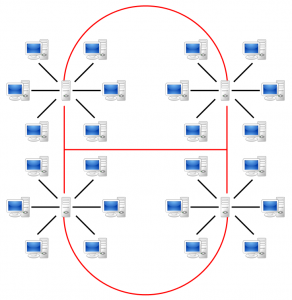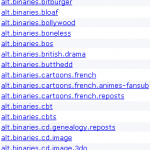Usenet - Introduction
Usenet is widely used all over the internet, but when you ask the common person, who knows about P2P(BitTorrent, etc) file sharing, they don’t know what it is. It seems even though it’s used all over, it’s only used by select groups. Generally, all these people fall into the “Techie” group. A lot of older people, who are technically inclined, know what it is but only what it was generally used for in their time.
The Big Picture
 Essentially Usenet is a central network server, but behind the scenes it’s much more. There is no single server that everyone connects to, instead there are thousands of servers out there, that all keep each other up to date. Take a look at the diagram to get a feel for what I am talking about. Each server communicates with all the other servers to keep up to date on what has just been recently added.
Essentially Usenet is a central network server, but behind the scenes it’s much more. There is no single server that everyone connects to, instead there are thousands of servers out there, that all keep each other up to date. Take a look at the diagram to get a feel for what I am talking about. Each server communicates with all the other servers to keep up to date on what has just been recently added.
Usenet is a world-wide distributed Internet discussion system. Basically, think of a forum. Usenet has “groups” that people can go to and read/post information to. The groups represent the categories a forum might have. Only Usenet is humongous and is distributed world-wide.
What do I mean by saying Usenet is “distributed world-wide”? Well, I mean there are slews of Usenet servers located all over the place. It’s like websites, there are so many of them you could never account for them all. The servers can all share the same groups and information. A posting to one of the groups would result on every server seeing the posting because they are all linked together.
Server Customization
 Obviously, servers have the ability to be customized by the owners though. Some servers only host certain groups and don’t include the rest. Also, retention span is a huge concern. Retention span is how long the server might hold a posting. If postings were never deleted and everything is world-wide and distributed, then the servers would have to be MASSIVE, which they already are, and still have a problem keeping up with the requirements given to them. That’s where retention span comes into play. The owner of the server can adjust the retention span based on different factors. Sometimes it’s based on a date so that after a certain date, the posting is removed from the server. Other times it’s based on group storage allocation. A “group” might be given a specified amount of storage space allowed to be consumed, and as they go over that amount, the server removes the oldest items first to clear up just enough space. That way, if a group is given 1 TB of data storage, if someone submits a post then the oldest items get removed. Only “enough” items get removed to allow space for the new items, which allows for maximizing storing as much as they can for as long as they can. Each servers retention span may differ, so you may want to watch for that when selecting a Usenet server.
Obviously, servers have the ability to be customized by the owners though. Some servers only host certain groups and don’t include the rest. Also, retention span is a huge concern. Retention span is how long the server might hold a posting. If postings were never deleted and everything is world-wide and distributed, then the servers would have to be MASSIVE, which they already are, and still have a problem keeping up with the requirements given to them. That’s where retention span comes into play. The owner of the server can adjust the retention span based on different factors. Sometimes it’s based on a date so that after a certain date, the posting is removed from the server. Other times it’s based on group storage allocation. A “group” might be given a specified amount of storage space allowed to be consumed, and as they go over that amount, the server removes the oldest items first to clear up just enough space. That way, if a group is given 1 TB of data storage, if someone submits a post then the oldest items get removed. Only “enough” items get removed to allow space for the new items, which allows for maximizing storing as much as they can for as long as they can. Each servers retention span may differ, so you may want to watch for that when selecting a Usenet server.
Usage
There are two ways that Usenet is really used. The first is like a social network, because it’s really just one huge forum. The other use is called “alt.binaries.*”, where the star designates any group beneath the “alt.binaries” group. For instance, there is “alt.binaries.dvd”, “alt.binaries.warez”, “alt.binaries.warez.0-day”, etc. Under these categories, people post binaries/programs/movies/music. For now on, we’ll refer to binaries as programs, movies, music, etc.
Terminology
Newsgroup
A newsgroup simply refers to a Usenet group. Newsgroups(groups) are basically equivalent to a category. They simply divide and categorize items in a manner that makes it easier for both those who are posting and those who are downloading.
Newsreader
A newsreader is the client you use to interact with a Usenet server. A newsreader will allow you to download binaries, as well as post them(usually). You’ll need some form of Newsreader to be able to use Usenet.
News Server
A news server is the Usenet server you are going to connect to, to be able to download and/or post files, etc.
Binary
A binary refers to a file, whether it be a movie, application, game, etc. Hence, why you only browse under alt.binaries.* for items of interest to download.
NZB
An NZB is a wonderful thing. It’s essentially an index file that most Newsreaders can use to automatically find, grab, and download all the items in the NZB. That way, you don’t have to find all the pieces yourself, you just use the NZB instead.
NFO
An NFO is a file that contains all the release information as well as branding by the people who made the release possible. Usually NFO’s are available for two reasons. 1) To tell you a bit about what the release is/contains. 2) To tell you who made it possible(groups, people, etc).
